ENSTILAR Dailymed
Generic: calcipotriene and betamethasone dipropionate is used for the treatment of Dermatitis, Atopic Facial Dermatoses Foot Dermatoses Hand Dermatoses Inflammation Leg Dermatoses Mycoses Pruritus Ani Psoriasis Scalp Dermatoses Dermatitis, Seborrheic Purpura, Thrombocytopenic, Idiopathic Hypercalcemia
Go PRO for all pill images
1 Indications And Usage
Enstilar® (calcipotriene and betamethasone dipropionate) Foam is indicated for the topical treatment of plaque psoriasis in patients 12 years and older.
Enstilar Foam is a combination of calcipotriene, a vitamin D analog, and betamethasone dipropionate, a corticosteroid, indicated for the topical treatment of plaque psoriasis in patients 12 years and older. (1 )
2 Dosage And Administration
Shake can prior to using Enstilar Foam. Apply Enstilar Foam to affected areas once daily for up to 4 weeks. The maximum dose should not exceed 60 grams every 4 days. Rub in Enstilar Foam gently. Wash hands after applying the product. Discontinue Enstilar Foam when control is achieved.
Enstilar Foam shouldnot be used:
- with occlusive dressings unless directed by a healthcare provider.
- on the face, groin, or axillae, or if skin atrophy is present at the treatment site.
Enstilar Foam is not for oral, ophthalmic, or intravaginal use.
- Shake before use. Apply Enstilar Foam to affected area(s) once daily for up to 4 weeks. Discontinue therapy when control is achieved. Do not use more than 60 grams every 4 days. (
2 )- Do not use with occlusive dressings unless directed by a healthcare provider. (
2 )- Avoid use on the face, groin, or axillae, or if skin atrophy is present at the treatment site. (
2 )- Not for oral, ophthalmic, or intravaginal use. (
2 )
3 Dosage Forms And Strengths
Enstilar Foam: 0.005%/0.064% - each gram contains 50 mcg calcipotriene and 0.643 mg of betamethasone dipropionate in a white to off-white opalescent liquid in a pressurized aluminum spray can with a continuous valve and actuator. At administration the product is a white to off-white foam after evaporation of the propellants.
Foam: 0.005%/0.064% - Each gram of Enstilar Foam contains 50 mcg of calcipotriene and 0.643 mg of betamethasone dipropionate. (3 )
4 Contraindications
None.
None. (4 )
5 Warnings And Precautions
- Flammability: The propellants in Enstilar Foam are flammable. Instruct the patient to avoid fire, flame, and smoking during and immediately following application. (
5.1 )- Hypercalcemia and Hypercalciuria: Hypercalcemia and hypercalciuria have been observed with use of Enstilar Foam. If hypercalcemia or hypercalciuria develop, discontinue treatment until parameters of calcium metabolism have normalized. (
5.2 )- Effects on Endocrine System: Topical corticosteroids can produce reversible hypothalamic-pituitary-adrenal (HPA) axis suppression with the potential for glucocorticosteroid insufficiency during and after withdrawal of treatment. Risk factors include the use of high-potency topical corticosteroids, use over a large surface area or on areas under occlusion, prolonged use, altered skin barrier, liver failure, and use in pediatric patients. Modify use should HPA axis suppression develop. (
5.3 ,8.4 )- Ophthalmic Adverse Reactions: Topical corticosteroid products may increase the risk of cataracts and glaucoma. If visual symptoms occur, consider referral to an ophthalmologist. (
5.5 )5.1 Flammability
The propellants in Enstilar Foam are flammable. Instruct the patient to avoid fire, flame, and smoking during and immediately following application.
5.2 Hypercalcemia and Hypercalciuria
Hypercalcemia and hypercalciuria have been observed with use of Enstilar Foam. If hypercalcemia or hypercalciuria develop, discontinue treatment until parameters of calcium metabolism have normalized. The incidence of hypercalcemia and hypercalciuria following Enstilar Foam treatment of more than 56 weeks has not been evaluated [see Clinical Pharmacology (12.2)].
5.3 Effects on Endocrine System
Hypothalamic-Pituitary-Adrenal Axis Suppression
Systemic absorption of topical corticosteroids can cause reversible hypothalamic-pituitary-adrenal (HPA) axis suppression with the potential for clinical glucocorticosteroid insufficiency. This may occur during treatment or upon withdrawal of treatment. Factors that predispose a patient to HPA axis suppression include the use of high-potency steroids, large treatment surface areas, prolonged use, use of occlusive dressings, altered skin barrier, liver failure, and young age.
Evaluation for HPA axis suppression may be done by using the adrenocorticotropic hormone (ACTH) stimulation test. If HPA axis suppression is documented, gradually withdraw Enstilar Foam, reduce the frequency of application, or substitute with a less potent corticosteroid.
The following trials evaluated the effects of Enstilar Foam on HPA axis suppression [see Clinical Pharmacology (12.2) ]:
- In a trial evaluating the effects of Enstilar Foam on the HPA axis, 35 adult subjects applied Enstilar Foam on the body and scalp. Adrenal suppression was not observed in any subjects after 4 weeks of treatment.
- In another trial, 33 adolescent subjects age 12 to 17 years applied Enstilar Foam on the body and scalp. Adrenal suppression occurred in 3 (9%) of the subjects.
- In a trial, 21 subjects aged 18 years and older with plaque psoriasis applied Enstilar Foam once daily for 4 weeks and then twice weekly on 2 non-consecutive days for 52 weeks, including once daily for 4 weeks if loss of response occurred. Adrenal suppression was observed in 2 (10%) of the subjects.
Cushing's Syndrome and Hyperglycemia
Systemic effects of topical corticosteroids may also include Cushing's syndrome, hyperglycemia, and glucosuria.
Additional Considerations for Endocrine Adverse Reactions
Pediatric patients may be more susceptible to systemic toxicity due to their larger skin surface to body mass ratios [see Use in Specific Populations (8.4)].
Use of more than one corticosteroid-containing product at the same time may increase the total systemic corticosteroid exposure.
5.4 Allergic Contact Dermatitis
Allergic contact dermatitis has been observed with topical calcipotriene and topical corticosteroids. Allergic contact dermatitis to a topical corticosteroid is usually diagnosed by observing a failure to heal rather than a clinical exacerbation. Corroborate such an observation with appropriate diagnostic patch testing.
5.5 Ophthalmic Adverse Reactions
Use of topical corticosteroids, including Enstilar® Foam, may increase the risk of posterior subcapsular cataracts and glaucoma. Cataracts and glaucoma have been reported with the postmarketing use of topical corticosteroid products. Avoid contact with Enstilar Foam with eyes. Enstilar Foam may cause eye irritation. Advise patients to report any visual symptoms and consider referral to an ophthalmologist for evaluation.
6 Adverse Reactions
Adverse reactions reported in < 1% of subjects included application site irritation, application site pruritus, folliculitis, skin hypopigmentation, hypercalcemia, urticaria, and exacerbation of psoriasis. (6.1 )
To report SUSPECTED ADVERSE REACTIONS, contact LEO Pharma Inc. at 1-877-494-4536 or FDA at 1-800-FDA-1088 or www.fda.gov/medwatch.
6.1 Clinical Trials Experience
Because clinical trials are conducted under widely varying conditions, adverse reaction rates observed in the clinical trials of a drug cannot be directly compared to rates in the clinical trials of another drug and may not reflect the rates observed in practice.
Clinical Trials Conducted in Subjects 18 years and older with Psoriasis
The rates of adverse reactions described below were from three randomized, multicenter, vehicle and/or active-controlled clinical trials in adult subjects with plaque psoriasis [see Clinical Studies (14)]. Subjects applied study product once daily for 4 weeks, and the median weekly dose of Enstilar Foam was 25 grams. Adverse reactions reported in <1% of adult subjects treated with Enstilar Foam included: application site irritation, application site pruritus, folliculitis, skin hypopigmentation, hypercalcemia, urticaria, and exacerbation of psoriasis.
Clinical Trials Conducted in Subjects 12 to 17 years with Psoriasis
In one uncontrolled clinical trial, 106 subjects aged 12 to 17 years with plaque psoriasis of the scalp and body applied Enstilar Foam once daily for up to 4 weeks. The median weekly dose was 40 grams. Adverse reactions reported in <1% of adolescent subjects treated were acne, erythema, application site pain, and skin reactions [see Use in Specific Populations (8.4) and Clinical Pharmacology (12.2)].
6.2 Postmarketing Experience
Because adverse reactions are reported voluntarily from a population of uncertain size, it is not always possible to reliably estimate their frequency or establish a causal relationship to drug exposure.
Postmarketing reports for local adverse reactions to Enstilar Foam included application site burning.
Postmarketing reports for local adverse reactions to topical corticosteroids included atrophy, striae, telangiectasia, dryness, perioral dermatitis, secondary infection, and miliaria.
Ophthalmic adverse reactions of cataracts, glaucoma, and increased intraocular pressure have been reported with the use of topical corticosteroids, including topical betamethasone products.
8 Use In Specific Populations
8.1 Pregnancy
Risk Summary
Available data with Enstilar Foam are not sufficient to evaluate a drug-associated risk for major birth defects, miscarriages, or adverse maternal or fetal outcomes. Although there are no available data on use of the calcipotriene component in pregnant women, systemic exposure to calcipotriene after topical administration of Enstilar Foam is likely to be low [see Clinical Pharmacology (12.3)].
Observational studies suggest an increased risk of having low birth weight infants with the maternal use of potent or super potent topical corticosteroids (see Data). Advise pregnant women that Enstilar® Foam may increase the potential risk of having a low birth weight infant and to use Enstilar Foam on the smallest area of skin and for the shortest duration possible.
In animal reproduction studies, oral administration of calcipotriene to pregnant rats during the period of organogenesis resulted in an increased incidence of minor skeletal abnormalities, including enlarged fontanelles and extra ribs (see Data). Oral administration of calcipotriene to pregnant rabbits during the period of organogenesis had no apparent effects on embryo-fetal development. Subcutaneous administration of betamethasone dipropionate to pregnant rats and rabbits during the period of organogenesis resulted in fetal toxicity, including fetal deaths, reduced fetal weight, and fetal malformations (cleft palate and crooked or short tail) (see Data). The available data do not allow the calculation of relevant comparisons between the systemic exposures of calcipotriene and betamethasone dipropionate observed in animal studies to the systemic exposures that would be expected in humans after topical use of Enstilar Foam.
The background risk of major birth defects and miscarriage in the indicated population is unknown. All pregnancies have a background risk of birth defect, loss, or other adverse outcomes. In the U.S. general population, the estimated background risk of major birth defects and miscarriage in clinically recognized pregnancies is 2% to 4% and 15% to 20%, respectively.
Data
Human Data
Available observational studies in pregnant women did not identify a drug-associated risk of major birth defects, preterm delivery, or fetal mortality with the use of topical corticosteroids of any potency. However, when the dispensed amount of potent or super potent topical corticosteroids exceeded 300 grams during the entire pregnancy, maternal use was associated with an increased risk of low birth weight in infants.
Animal Data
Embryo-fetal development studies with calcipotriene were performed by the oral route in rats and rabbits. Pregnant rats received dosages of 0, 6, 18, or 54 mcg/kg/day (0, 36, 108, and 324 mcg/m2/day, respectively) on days 6-15 of gestation (the period of organogenesis). There were no apparent effects on maternal survival, behavior, or body weight gain, no effects on litter parameters, and no effects on the incidence of major malformations in fetuses. Fetuses from dams dosed at 54 mcg/kg/day exhibited a significantly increased incidence of minor skeletal abnormalities, including enlarged fontanelles and extra ribs.
Pregnant rabbits were dosed daily with calcipotriene at exposures of 0, 4, 12, or 36 mcg/kg/day (0, 48, 144, and 432 mcg/m2/day, respectively) on days 6-18 of gestation (the period of organogenesis). Mean maternal body weight gain was reduced in animals dosed at 12 or 36 mcg/kg/day. The incidence of fetal deaths was increased in the group dosed at 36 mcg/kg/day; reduced fetal weight was also observed in this group. The incidence of major malformations among fetuses was not affected. An increase in the incidence of minor skeletal abnormalities, including incomplete ossification of sternebrae, pubic bones, and forelimb phalanges, was observed in the group dosed at 36 mcg/kg/day.
Embryo-fetal development studies with betamethasone dipropionate were performed via subcutaneous injection in mice and rabbits. Pregnant mice were administered doses of 0, 156, 625, or 2500 mcg/kg/day (0, 468, 1875, and 7500 mcg/m2/day, respectively) on days 7 through 13 of gestation (the period of organogenesis). Betamethasone dipropionate induced fetal toxicity, including fetal deaths, reduced fetal weight, malformations (increased incidence of the cleft palate and crooked or short tail), and minor skeletal abnormalities (delayed ossification of vertebra and sternebrae). Fetal toxicity was observed at the lowest exposure that was evaluated (156 mcg/kg/day).
Pregnant rabbits were injected subcutaneously at dosages of 0, 0.625, 2.5, and 10 mcg/kg/day (0, 7.5, 30, and 120 mcg/m2/day, respectively) on days 6 through 18 of gestation (the period of organogenesis). Betamethasone dipropionate induced fetal toxicity, including fetal deaths, reduced fetal weight, external malformations (including malformed ears, cleft palate, umbilical hernia, kinked tail, club foot, and club hand), and skeletal malformations (including absence of phalanges of the first digit and cranial dysplasia) at dosages of 2.5 mcg/kg/day and above.
Calcipotriene was evaluated for effects on peri- and post-natal development when orally administered to pregnant rats at dosages of 0, 6, 18 or 54 mcg/kg/day (0, 36, 108, and 324 mcg/m2/day, respectively) from gestation day 15 through day 20 postpartum. No remarkable effects were observed on any parameter, including survival, behavior, body weight, litter parameters, or the ability to nurse or rear pups.
Betamethasone dipropionate was evaluated for effects on peri- and post-natal development when orally administered to pregnant rats at dosages of 0, 100, 300, and 1000 mcg/kg/day (0, 600, 1800, and 6000 mcg/m2/day, respectively) from gestation day 6 through day 20 postpartum. Mean maternal body weight was significantly reduced on gestation day 20 in animals dosed at 300 and 1000 mcg/kg/day. The mean duration of gestation was slightly, but statistically significantly, increased at 100, 300, and 1000 mcg/kg/day. The mean percentage of pups that survived to day 4 was reduced in relation to dosage. On lactation day 5, the percentage of pups with a reflex to right themselves when placed on their back was significantly reduced at 1000 mcg/kg/day. No effects on the ability of pups to learn were observed, and the ability of the offspring of treated rats to reproduce was not affected.
8.2 Lactation
Risk Summary
There is no information regarding the presence of topically administered calcipotriene and betamethasone dipropionate in human milk, the effects on the breastfed infant, or the effects on milk production. Concentrations of calcipotriene in plasma are low after topical administration, and therefore, concentrations in human milk are likely to be low [see Clinical Pharmacology (12.3)]. It is not known whether topical administration of large amounts of betamethasone dipropionate could result in sufficient systemic absorption to produce detectable quantities in human milk. The developmental and health benefits of breastfeeding should be considered along with the mother's clinical need for Enstilar® Foam and any potential adverse effects on the breastfed child from Enstilar Foam or from the underlying maternal condition.
Clinical Considerations
To minimize potential exposure to the breastfed infant via breast milk, use Enstilar Foam on the smallest area of skin and for the shortest duration possible while breastfeeding. Advise breastfeeding women not to apply Enstilar Foam directly to the nipple and areola to avoid direct infant exposure [see Use in Specific Populations (8.4)].
8.4 Pediatric Use
The safety and effectiveness of Enstilar Foam for the treatment of mild to severe plaque psoriasis have been established in pediatric patients age 12 to 17 years. The use of Enstilar Foam for this indication is supported by evidence from adequate and well-controlled trials in adults and from one uncontrolled trial in 106 adolescents age 12 to 17 years with psoriasis of the body and scalp. Calcium metabolism was evaluated in all pediatric subjects and no cases of hypercalcemia or clinically relevant changes in urinary calcium were reported. Hypothalamic pituitary adrenal (HPA) axis suppression was evaluated in a subset of 33 pediatric subjects with moderate plaque psoriasis of the body and scalp (mean body surface area involvement of 16% and mean scalp area involvement of 56%). After 4 weeks of once daily treatment witha mean weekly dose of 47 grams, HPA axis suppression was observed in 3 of 33 subjects (9%) [see Warnings and Precautions (5.2), Adverse Reactions (6.1) and Clinical Pharmacology (12.2)].
Because of a higher ratio of skin surface area to body mass, children under the age of 12 years are at particular risk of systemic adverse effects when they are treated with topical corticosteroids. Pediatric patients are, therefore, also at greater risk of HPA axis suppression and adrenal insufficiency with the use of topical corticosteroids including Enstilar Foam [see Warnings and Precautions (5.3) and Clinical Pharmacology (12.2)].
Cushing's syndrome, linear growth retardation, delayed weight gain, and intracranial hypertension have been reported in pediatric patients treated with topical corticosteroids.
Local adverse reactions including striae have been reported with use of topical corticosteroids in pediatric patients.
The safety and effectiveness of Enstilar Foam in pediatric patients less than 12 years of age have not been established.
8.5 Geriatric Use
Of the total number of subjects in the controlled clinical studies of Enstilar Foam, 97 subjects were 65 years and over, and 21 were 75 and over.
No overall differences in safety or effectiveness of Enstilar Foam were observed between these subjects and younger subjects, and other reported clinical experience has not identified differences in responses between the elderly and younger patients, but greater sensitivity of some older individuals cannot be ruled out.
11 Description
Enstilar Foam contains calcipotriene hydrate and betamethasone dipropionate. It is for topical use only.
Calcipotriene Hydrate
Calcipotriene hydrate is a synthetic vitamin D analog and has the chemical name 9,10-secochola-5,7,10(19),22-tetraene-1,3,24-triol,24-cyclo-propyl-,monohydrate, (1α,3β,5Z,7E,22E,24S) with the empirical formula C27H40O3∙H2O), a molecular weight of 430.6, and the following structural formula (calcipotriene hydrate is a white to almost white, crystalline compound):

Betamethasone Dipropionate
Betamethasone dipropionate is a synthetic corticosteroid and has the chemical name pregna-1,4-diene-3,20-dione-9-fluoro-11-hydroxy-16-methyl-17,21-bis(1-oxypropoxy)-(11β,16β), with the empirical formula C28H37FO7, a molecular weight of 504.6, and the following structural formula (betamethasone dipropionate is a white to almost white, crystalline powder):
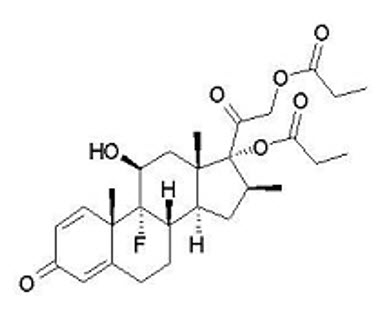
Enstilar® Foam
Each gram of Enstilar Foam contains 50 mcg of calcipotriene (equivalent to 52.2 mcg of calcipotriene hydrate) and 0.643 mg of betamethasone dipropionate (equivalent to 0.5 mg of betamethasone) in a base of white petrolatum, polyoxypropylene stearyl ether, mineral oil, all-rac-alpha-tocopherol, and butylhydroxytoluene. Enstilar Foam is a white to off-white opalescent liquid in a pressurized aluminum spray can with a continuous valve and actuator. The propellants used in Enstilar Foam are dimethyl ether and butane. At administration, the product is a white to off-white foam after evaporation of the propellants. Enstilar Foam has the appearance of a non-expanding foam that gradually collapses after spraying.
12 Clinical Pharmacology
12.1 Mechanism of Action
Enstilar Foam combines the pharmacological effects of calcipotriene hydrate as a synthetic vitamin D3 analog and betamethasone dipropionate as a synthetic corticosteroid. However, while their pharmacologic and clinical effects are known, the exact mechanisms of their actions in the treatment of plaque psoriasis are unknown.
12.2 Pharmacodynamics
Hypothalamic-Pituitary-Adrenal (HPA) Axis Suppression:
HPA axis suppression as indicated by a 30-minute post-stimulation cortisol level of ≤18 mcg/dL was evaluated in the following trials [see Warnings and Precautions (5.3)]:
- Enstilar Foam was applied to adult subjects (N=35) with moderate to severe plaque psoriasis affecting a mean body surface area of 18% (range 12 to 28%) and mean scalp area of 50 % (range 30 to 100%). The mean ± SD weekly dose used was 62 ± 28 grams. HPA axis suppression was not observed in any subjects after 4 weeks of treatment. Lack of adrenal suppression observed in this trial does not rule out the risk of HPA axis suppression.
- Enstilar Foam was applied to adolescent subjects (N=33) age 12 to 17 years with moderate plaque psoriasis affecting a mean body surface area of 16% (range from 10% to 21%) and mean scalp area of 56% (range from 25% to 90%). The mean ± SD weekly dose used was 47 ± 22 grams. HPA axis suppression was observed in 3 (9%) of the subjects.
- Enstilar® Foam was applied once daily for 4 weeks to adult subjects (N=21) with plaque psoriasis affecting a mean body surface area of 15% (range 10 to 30%), then twice weekly on 2 non-consecutive days for 52 weeks with 4 weeks and once daily treatment was resumed if loss of response occurred. The mean ± SD total dose used in the 52-week period was 1400 ± 905 grams (including total dose of 528 ± 650 grams used in the loss of response period). HPA axis suppression was observed in 2 (10%) of the subjects at Week 56.
Effects on Calcium Metabolism
- Effects of once daily application of Enstilar Foam for 4 weeks on calcium metabolism in adult subjects (N=564) with plaque psoriasis were examined in three randomized, multicenter, vehicle- and/or active-controlled clinical trials. Following once daily application of Enstilar Foam, elevated serum calcium levels outside the normal range were observed in 3 subjects. Elevated urinary calcium levels outside the normal range were observed in 17 subjects.
- In a trial, calcium metabolism was evaluated in 106 adolescent subjects aged 12 to 17 years with plaque psoriasis of the scalp and body after once daily application of Enstilar Foam for 4 weeks. No cases of hypercalcemia and no clinically relevant changes in urinary calcium were reported.
- In a trial, 272 subjects aged 18 years and older with plaque psoriasis applied Enstilar Foam once daily for 4 weeks and then twice weekly on 2 non-consecutive days for 52 weeks, including once daily for 4 weeks if loss of response occurred. No cases of hypercalcemia and no clinically relevant changes in urinary calcium were reported.
Vasoconstrictor Assay
Enstilar Foam is in the mid to potent range corticosteroid as demonstrated by studies in healthy subjects when compared with other topical corticosteroids. However, similar blanching scores do not necessarily imply therapeutic equivalence.
12.3 Pharmacokinetics
Absorption
The PK of Enstilar Foam was investigated in both adults (N = 35) and a subset of pediatric subjects with plaque psoriasis age 12 to 17 years (N=33) following once daily application of Enstilar Foam on the body and scalp for 4 weeks.
Enstilar Foam was applied to adult subjects with moderate to severe plaque psoriasis affecting a mean body surface area of 18% and mean scalp area of 50%. Following application of a mean ± SD weekly dose of 62 ± 28 grams of Enstilar Foam, calcipotriene was quantifiable in 1 of 35 (3%) subjects and its main metabolite, MC1080, in 3 of 35 (9%) subjects. For subjects with measurable concentrations, the maximal plasma concentrations (Cmax) and area under the concentration curve until the last measured time point (AUClast) for calcipotriene were 55.9 pg/mL and 82.5 pg*h/mL, respectively; and the mean ± SD Cmax and AUClast for MC1080 was 24.4 ± 1.9 pg/mL and 59.3 ± 5.4 pg*h/mL, respectively. Betamethasone dipropionate was quantifiable in 5 of 35 (14%) subjects and its main metabolite, betamethasone 17-propionate (B17P), was quantifiable in 27 of 35 (77%) subjects. The mean ± SD Cmax and AUClast for betamethasone dipropionate were 52.2 ± 19.7 pg/mL and 36.5 ± 27.4 pg*h/mL, respectively and for B17P were 147.9 ± 224.0 pg/mL and 683.6 ± 910.6 pg*h/mL, respectively.
Enstilar Foam was applied to pediatric subjects age 12 to 17 years with moderate plaque psoriasis affecting a mean body surface area of 16% and mean scalp area of 56%. Following application of a mean ± SD weekly dose of 47 ± 22 grams of Enstilar Foam, calcipotriene and its metabolite MC1080 were below the lower limit of quantification in all plasma samples. Betamethasone dipropionate was quantifiable in 12 of 33 (36%) subjects with the Cmax ranging from 31.1-480 pg/mL. The metabolite of betamethasone 17-propionate (B17P) was quantifiable in 6 of 33 (18%) subjects with the Cmax ranging from 30.8–91.7 pg/mL.
Elimination
Metabolism
13 Nonclinical Toxicology
13.1 Carcinogenesis, Mutagenesis, Impairment of Fertility
When calcipotriene was applied topically to mice for up to 24 months at dosages of 3, 10, and 30 mcg/kg/day (9, 30, and 90 mcg/m2/day, respectively), no significant changes in tumor incidence were observed when compared to control.
A 104-week oral carcinogenicity study was conducted with calcipotriene in male and female rats at doses of 1, 5, and 15 mcg/kg/day (6, 30, and 90 mcg/m2/day, respectively). Beginning week 71, the dosage for high-dose animals of both genders was reduced to 10 mcg/kg/day (60 mcg/m2/day). A treatment-related increase in benign C-cell adenomas was observed in the thyroid of females that received 15 mcg/kg/day. A treatment-related increase in benign pheochromocytomas was observed in the adrenal glands of males that received 15 mcg/kg/day. No other statistically significant differences in tumor incidence were observed when compared to control. The relevance of these findings to patients is unknown.
When betamethasone dipropionate was applied topically to CD-1 mice for up to 24 months at dosages approximating 1.3, 4.2, and 8.5 mcg/kg/day in females, and 1.3, 4.2, and 12.9 mcg/kg/day in males (up to 26 mcg/m2/day and 39 mcg/m2/day, in females and males, respectively), no significant changes in tumor incidence were observed when compared to control.
When betamethasone dipropionate was administered via oral gavage to male and female Sprague Dawley rats for up to 24 months at dosages of 20, 60, and 200 mcg/kg/day (120, 360, and 1200 mcg/m2/day, respectively), no significant changes in tumor incidence were observed when compared to control.
Calcipotriene did not elicit any genotoxic effects in the Ames mutagenicity assay, the mouse lymphoma TK locus assay, the human lymphocyte chromosome aberration test, or the mouse micronucleus test. Betamethasone dipropionate did not elicit any genotoxic effects in the Ames mutagenicity assay, the mouse lymphoma TK locus assay, or in the rat micronucleus test.
Studies in rats with oral doses of up to 54 mcg/kg/day (324 mcg/m2/day) of calcipotriene indicated no impairment of fertility or general reproductive performance. Studies in male rats at oral doses of up to 200 mcg/kg/day (1200 mcg/m2/day), and in female rats at oral doses of up to 1000 mcg/kg/day (6000 mcg/m2/day), of betamethasone dipropionate indicated no impairment of fertility.
14 Clinical Studies
Two multicenter, randomized, double-blind trials were conducted in adult subjects with plaque psoriasis.
- In Trial One, 302 subjects were randomized to 1 of 3 treatment groups: Enstilar® Foam, betamethasone dipropionate in the same vehicle, or calcipotriene in the same vehicle.
- In Trial Two, 426 subjects were randomized to one of two treatment groups: Enstilar Foam or the vehicle alone. Baseline disease severity was graded using a 5-point Investigator's Global Assessment (IGA). At baseline subjects scored "Mild", "Moderate", or "Severe". The majority of subjects in both trials (76% and 75%) had disease of "Moderate" severity at baseline, 14% and 15% of subjects had disease of "Mild" severity at baseline and 10% of subjects had "Severe" disease at baseline in both trials. The extent of disease involvement assessed by mean body surface area was 7.1% (range 2 to 28%) and 7.5% (range 2 to 30%). In both trials, subjects were treated once daily for up to 4 weeks.
Efficacy was assessed with treatment success defined as the proportion of subjects at Week 4 who were "Clear" or "Almost Clear" according to the IGA. Subjects with "Mild" disease at baseline were required to be "Clear" to be considered a treatment success. Table 1 presents the efficacy results for these trials.
Table 1. Percentage of Subjects Achieving Treatment Success According to the Investigator's Global Assessment of Disease Severity Subjects with "Mild" disease at baseline were required to be "Clear" to be considered a treatment success. Enstilar Foam Betamethasone dipropionate in vehicle Calcipotriene in vehicle Vehicle Trial One Week 4 (N=100)45.0% (N=101)30.7% (N=101)14.9% -- Trial Two Week 4 (N=323)53.3% -- -- (N=103)4.8%
Long-term Use
A randomized, double-blind, vehicle-controlled trial (NCT02899962) evaluated the long-term use of Enstilar Foam in subjects who achieved treatment success (defined as IGA score of "Clear" or "Almost Clear" with at least a 2 grade improvement from baseline) after an initial 4-week treatment with once daily Enstilar Foam. These subjects (N=521) were randomized to receive Enstilar Foam or vehicle foam twice weekly on 2 non-consecutive days for up to 52 additional weeks. Subjects experiencing loss of response (defined as an IGA score of at least "Mild") were treated once daily with Enstilar® Foam for 4 weeks, and those who regained an IGA score of "Clear" or "Almost Clear" after 4 weeks then continued randomized treatment. Disease severity was graded using a 5-point IGA. The majority of subjects in this trial (82%) had disease of "Moderate" severity at baseline, 11% of subjects had disease of "Mild" severity at baseline, and 7% of subjects had "Severe" disease at baseline. The extent of disease involvement assessed by mean body surface area was 8.3% (range 1 to 38%) at baseline.
The median time to loss of response was 56 days for subjects treated with Enstilar Foam twice weekly compared to 30 days for subjects treated with vehicle foam twice weekly. Over the 52-week assessment period, subjects in the Enstilar Foam twice weekly group experienced loss of response a median of 2.0 times compared to 3.0 times for subjects in the vehicle foam twice weekly group. Figure 1 presents the percentage of subjects maintaining an IGA score of "Clear" or "Almost Clear" through Week 52 after randomization.
Figure 1: Percentage of Subjects Maintaining an IGA Score of "Clear" or "Almost Clear" Through Week 52 After Randomization
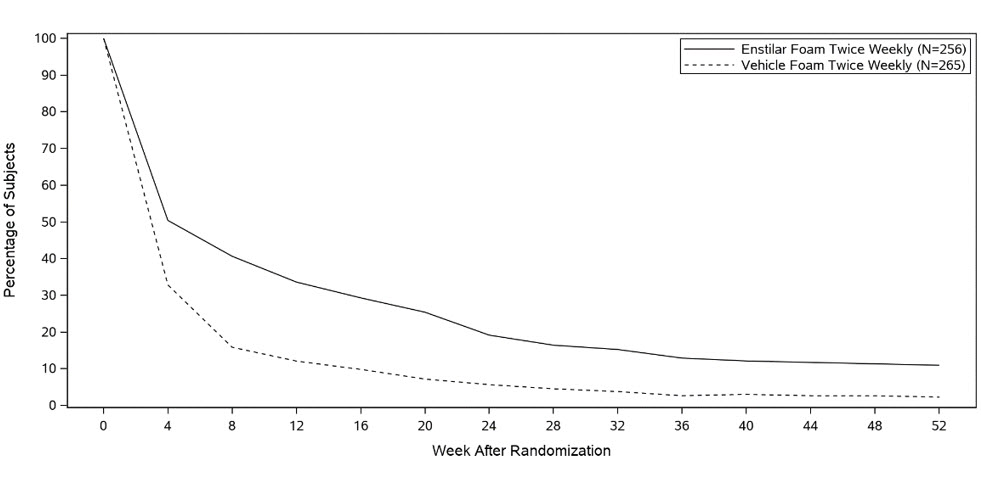
16 How Supplied/storage And Handling
16.1 How Supplied
Enstilar (calcipotriene and betamethasone dipropionate) Foam, 0.005%/0.064% is a white to off-white opalescent liquid in a pressurized aluminum spray can with a continuous valve and actuator. At administration, the product is a white to off-white foam after evaporation of the propellants. It is available as:
- 60 gram can (NDC 50222-302-60)
- 120 gram (2 cans of 60 gram) (NDC 50222-302-66)
16.2 Storage
- Store Enstilar Foam at 20°C - 25°C (68°F - 77°F); excursions permitted between 15°C - 30°C (59°F - 86°F). [See USP controlled room temperature].
- Contents under pressure. Do not puncture or incinerate. Do not expose to heat or store at temperatures above 120°F (49°C). Do not freeze.
- Unused product should be discarded six months after the can has been opened.
- Keep out of the reach of children.
16.3 Handling
- Enstilar Foam is flammable; avoid heat, flame or smoking when using this product.
17 Patient Counseling Information
See FDA-approved patient labeling (Patient Information and Instructions for Use).
Flammability
Instruct patients that Enstilar Foam is flammable; avoid heat, flame, or smoking when applying this medication.
Administration Instructions
- Shake before use and spray the foam by holding the can in any orientation except horizontally.
- Gently rub in Enstilar Foam to your affected areas.
- Do not use more than 60 grams every 4 days.
- Discontinue therapy when control is achieved unless directed otherwise by the healthcare provider.
- Avoid use of Enstilar Foam on the face, underarms, groin or eyes. If this medicine gets on face or in mouth or eyes, wash area right away.
- Do not occlude the treatment area with a bandage or other covering unless directed by the healthcare provider. Instruct the patients not to use other products containing calcipotriene or a corticosteroid with Enstilar Foam without first talking to the healthcare provider.
- Wash hands after application.
Local Reactions and Skin Atrophy
Advise patients that local reactions and skin atrophy are more likely to occur with occlusive use, prolonged use or use of higher potency corticosteroids.
Hypercalcemia and Hypercalciuria
Advise patients that hypercalcemia and hypercalciuria have been observed with the use of Enstilar Foam [see Warnings and Precautions (5.2)].
HPA Axis Suppression, Cushing's Syndrome, and Hyperglycemia
Advise patients that Enstilar Foam can cause HPA axis suppression, Cushing's syndrome, and/or hyperglycemia [see Warnings and Precautions (5.3)].
Ophthalmic Adverse Reactions
Advise patients to avoid contact of Enstilar Foam with eyes and to report any visual symptoms [see Warnings and Precautions (5.5)].
Pregnancy and Lactation
- Advise pregnant women that Enstilar Foam may increase the potential risk of having a low birth weight infant and to use Enstilar Foam on the smallest area of skin and for the shortest duration possible [see Use in Specific Populations (8.1)].
- Advise breastfeeding women not to apply Enstilar Foam directly to the nipple and areola to avoid direct infant exposure [see Use in Specific Populations (8.2)].
Manufactured by: LEO Laboratories Ltd., 285 Cashel Road, Dublin 12, Ireland
Distributed by: LEO Pharma Inc., Madison, NJ 07940, USA
Enstilar® is a registered trademark of LEO Pharma A/S.© 2022, LEO Pharma Inc. All rights reserved.
Spl Patient Package Insert Section
PATIENT INFORMATIONENSTILAR® [EN-still-ar](calcipotriene and betamethasone dipropionate)Foam This Patient Information has been approved by the U.S. Food and Drug Administration. Revised: 4/2022 Important: Enstilar Foam is for use on skin only (topical). Do not get Enstilar Foam near or in your mouth, eyes, or vagina. There are other medicines that contain the same medicine that is in Enstilar Foam and are used to treat plaque psoriasis. Do not use other products containing calcipotriene or a corticosteroid medicine with Enstilar Foam without talking to your healthcare provider first. What is Enstilar Foam? Enstilar Foam is a prescription medicine used on the skin (topical) to treat plaque psoriasis in people 12 years of age and older.It is not known if Enstilar Foam is safe and effective in children under 12 years of age. Before you use Enstilar Foam, tell your healthcare provider about all of your medical conditions, including if you:
- have a calcium metabolism disorder.
- Have thinning skin (atrophy) at the treatment site
- are pregnant or plan to become pregnant. It is not known if Enstilar Foam will harm your unborn baby. Enstilar Foam may increase your chance of having a low birth weight baby. If you use Enstilar Foam during pregnancy, use Enstilar Foam on the smallest area of the skin and for the shortest time needed.
- are breastfeeding or plan to breastfeed. It is not known if Enstilar Foam passes into your breast milk. Breastfeeding women should use Enstilar Foam on the smallest area of the skin and for the shortest time needed. Do not apply Enstilar Foam directly to your nipple and areola to avoid contact with your baby.
Tell your healthcare provider about all the medicines you take, including prescription and over-the-counter medicines, vitamins and herbal supplements.
How should I use Enstilar Foam? See the "Instructions for Use" for detailed information about the right way to use Enstilar Foam.
- Use Enstilar Foam exactly as your healthcare provider tells you to use it.
- Your healthcare provider should tell you how much Enstilar Foam to use and where to use it.
- Apply Enstilar Foam to the affected areas of your skin 1 time a day for up to 4 weeks. You should stop treatment when your plaque psoriasis is under control unless your healthcare provider gives you other instructions.
- Do not use more than 60 grams of Enstilar Foam every 4 days.
- Do not use Enstilar Foam longer than prescribed. Using too much Enstilar Foam, or using it too often, or for too long can increase your risk for having serious side effects.
- Shake the Enstilar Foam can before you use it.
- Gently rub in Enstilar Foam to your affected areas.
- Avoid using Enstilar Foam on your face, groin, or armpits, or if you have thinning of your skin (atrophy) at the treatment site.
- If you accidentally get Enstilar Foam on your face, in your mouth or in your eyes, wash the area with water right away.
- Wash your hands after using Enstilar Foam unless you are using the medicine to treat your hands.
- Do not bandage or cover the treated skin area, unless instructed by your healthcare provider.
What should I avoid while using Enstilar Foam? Enstilar Foam is flammable. Avoid fire, flame, and smoking when applying and right after you apply Enstilar Foam. What are the possible side effects of Enstilar Foam? Enstilar Foam may cause serious side effects, including:
- Too much calcium in your blood or urine. Your healthcare provider may tell you to stop or temporarily stop treatment with Enstilar Foam if you have too much calcium in your blood or urine. Your healthcare provider may do blood and urine tests to check your calcium levels and adrenal gland function while you are using Enstilar Foam.
- Enstilar ® Foam can pass through your skin. Too much Enstilar Foam passing through your skin can cause your adrenal glands to stop working properly. Your healthcare provider may do blood tests to check for adrenal gland problems. Your healthcare provider may tell you to stop or temporarily stop treatment with Enstilar Foam.
- Cushing's syndrome, a condition that happens when your body is exposed to too much of the hormone cortisol.
- High blood sugar (hyperglycemia) and sugar in your urine
- Skin problems, including reactions where Enstilar Foam is applied, and allergic reactions (allergic contact dermatitis). Tell your healthcare provider if you have any skin problems, including:
- thinning of your skin
- burning
- inflammation
- itiching
- irritation
- dryness
- changes in skin color
- redness
- infection
- raised bumps on your skin
The most common side effects of Enstilar Foam include:
- Eye problems. Using Enstilar Foam may increase your chance of getting cataracts and glaucoma. Do not get Enstilar Foam in your eyes because it may cause eye irritation. Tell your healthcare provider if you have blurred vision or other vision problems during treatment with Enstilar Foam.
- irritation
- itching
- inflamed hair pores (folliculitis)
- changes in skin color
- rash with raised red bumps or skin welts (hives)
- worsening of your psoriasis
These are not all the possible side effects of Enstilar Foam.
Call your doctor for medical advice about side effects. You may report side effects to FDA at 1-800-FDA-1088.
How should I store Enstilar Foam? Keep Enstilar Foam and all medicines out of the reach of children.
- Store Enstilar Foam at room temperature between 68°F to 77°F (20°C to 25°C).
- Do not expose Enstilar Foam to heat or store at temperatures above 120°F (49°C).
- Do not puncture or burn the Enstilar Foam can.
- Do not freeze Enstilar Foam.
- Enstilar Foam has an expiration date (exp.) marked on the can. Do not use after this date.
- Throw away (dispose of) unused Enstilar Foam 6 months after the can has been opened.
General information about the safe and effective use of Enstilar Foam. Medicines are sometimes prescribed for purposes other than those uled in a Patient Information leaflet. Do not use Enstilar Foam for a condition for which it was not prescribed. Do not give Enstilar Foam to other people, even if they have the same symptoms you have. It may harm them. You can ask your pharmacist or healthcare provider for information about Enstilar Foam that is written for health professionals. What are the ingredients in Enstilar Foam? Active ingredients: calcipotriene and betamethasone dipropionate. Inactive ingredients: white petrolatum, polyoxypropylene stearyl ether, mineral oil, all-rac-alpha-tocopherol, and butylhydroxytoluene. Propellants: dimethyl ether and butane. Manufactured by: LEO Laboratories Ltd., 285 Cashel Road, Dublin 12, IrelandDistributed by: LEO Pharma Inc., Madison, NJ 07940, USA Enstilar® is a registered trademark of LEO Pharma A/S.© 2022, LEO Pharma Inc. All rights reserved.
Instructions For Use Enstilar [en-still-ar] (calcipotriene And Betamethasone Dipropionate)foam
This Instructions for Use contains information on how to apply Enstilar Foam.
Important Information You Need to Know Before Applying Enstilar Foam: Enstilar Foam is for use on skin only (topical). Do not get Enstilar Foam near or in your mouth, eyes or vagina. If you accidentally get Enstilar Foam on the face, in the mouth or in the eyes, wash the area with water right away. Do not swallow Enstilar Foam.
Applying Enstilar Foam:
Follow your healthcare provider's instructions on how much Enstilar Foam to use and where to use it.
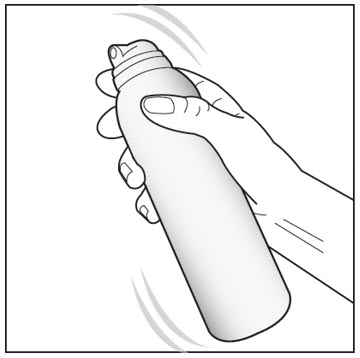
Wash your hands before applying Enstilar Foam. Step 1: Remove the cap from the can. Shake the can before use.
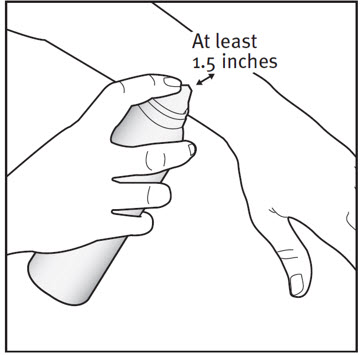
Step 2: Hold the can at least 1.5 inches from the affected area.
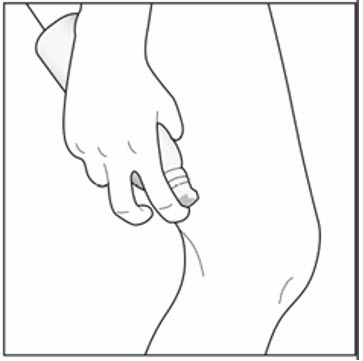
Step 3: The foam can be sprayed holding the can in any position except sideways (horizontally).To spray, push down on the nozzle. Note: Enstilar Foam will slowly become smaller in size after spraying.
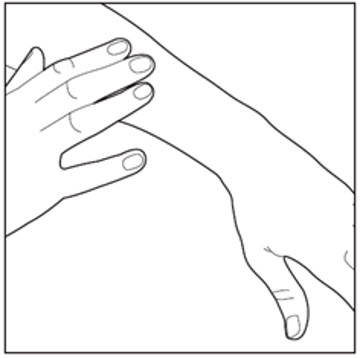
Step 4: Gently rub in Enstilar Foam into your affected skin area. Repeat the steps above to apply Enstilar Foam to other affected areas as instructed by your healthcare provider. Step 5: After applying Enstilar Foam, put the cap back on the can. Step 6: Wash your hands after using Enstilar Foam unless you are using the medicine to treat your hands.
Storing Enstilar Foam
- Store Enstilar Foam at room temperature between 68°F to 77°F (20°C to 25°C).
- Do not expose Enstilar Foam to heat or store at temperatures above 120°F (49°C).
- Do not puncture or burn the Enstilar Foam can.
- Do not freeze Enstilar Foam.
Disposing of Enstilar Foam
- Enstilar Foam has an expiration date (exp.) marked on the can. Do not use after this date.
- Throw away (dispose of) unused Enstilar Foam 6 months after the can has been opened.
Keep Enstilar Foam and all medicines out of the reach of children.
Manufactured by:LEO Laboratories Ltd.285 Cashel RoadDublin 12, Ireland
Distributed by:LEO Pharma Inc.Madison, NJ 07940, USA
Enstilar® is a registered trademark of LEO Pharma A/S.© 2022, LEO Pharma Inc. All rights reserved.
This Instructions for Use has been approved by the U.S. Food and Drug Administration.Revised: 4/2022
Principal Display Panel - 60 Gram Can Carton
NDC 50222-302-60
Rx only
Enstilar® (calcipotriene and betamethasone dipropionate) Foam, 0.005%/0.064%
Shake before Use
For Topical Use Only
Not for oral, ophthalmic, or intravaginal use
Net Wt. 60 gram
LEO®
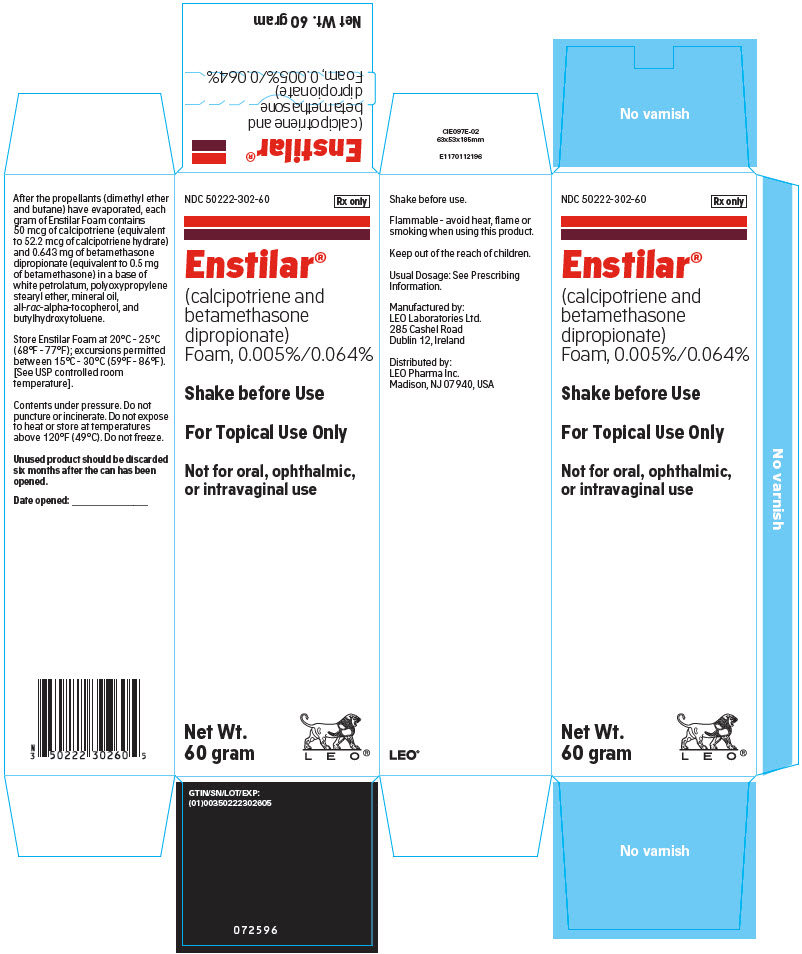
Principal Display Panel - 120 Gram Can Carton
NDC 50222-302-66Rx only
Enstilar® (calcipotriene and betamethasone dipropionate) Foam, 0.005%/0.064%
Shake before Use
For Topical Use OnlyÂ
Not for oral, ophthalmic, or intravaginal use
Net Wt. 120 gram (2 cans of 60 gram)
LEO®
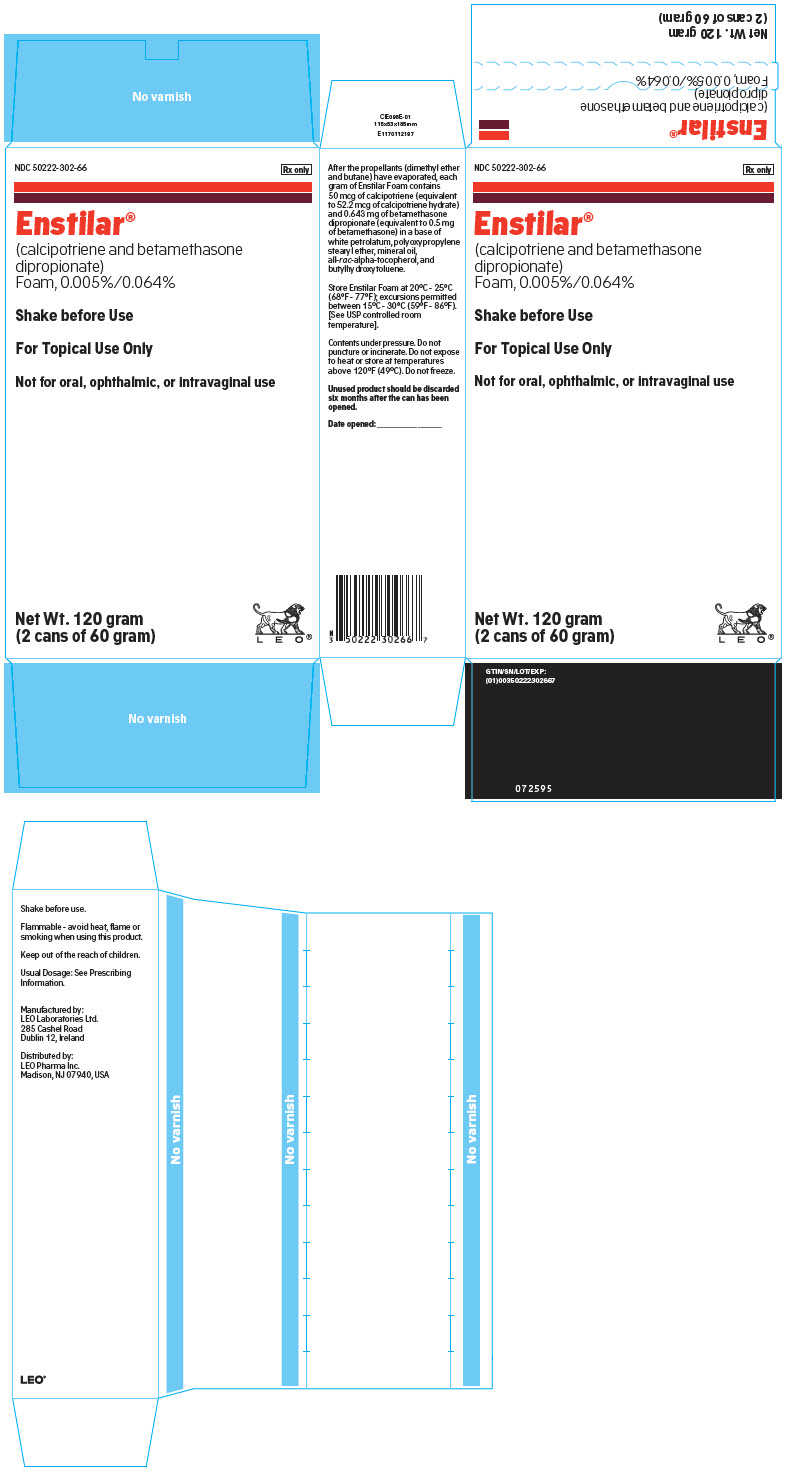
DISCLAIMER:
"This tool does not provide medical advice, and is for informational and educational purposes only, and is not a substitute for professional medical advice, treatment or diagnosis. Call your doctor to receive medical advice. If you think you may have a medical emergency, please dial 911."
"Do not rely on openFDA to make decisions regarding medical care. While we make every effort to ensure that data is accurate, you should assume all results are unvalidated. We may limit or otherwise restrict your access to the API in line with our Terms of Service."
"This product uses publicly available data from the U.S. National Library of Medicine (NLM), National Institutes of Health, Department of Health and Human Services; NLM is not responsible for the product and does not endorse or recommend this or any other product."
PillSync may earn a commission via links on our site


